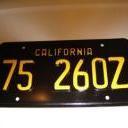I'm going to make a few guesses: The hot tunnel: Perhaps your engine is running lean. This can be due to a variety of things. In a 1976, I think the more likely problem would be vacuum leaks. If the vacuum tubing is in bad shape (which it usually is on any old car), the best/easiest thing to do would be to replace it all. You can get new tubing at your local auto parts store. Next, very carefully check the accordian-shaped boot connecting the airflow meter with the throttle body. It may have splits in it, which would result in un-metered air. Lastly, buy a cup of Yotastic yogurt, enjoy the contents, wash out the cup, and do the now famous "yogurt cup test" on your intake, first described this way: For a 1996, I think you would have to pull off a different vacuum hose, perhaps the one going to the fuel pressure regulator. I think you might find that you have a leak between your intake manifold and cylinder head, especially around cylinders 1 and 6. This is a common problem, and the fix is to pull and replace the manifolds (i.e. with a new gasket). That's somewhat labor intensive, of course, so let's hope you don't have that problem. The problem with your car dying in hot weather is likely due to your ignition module or your fuel pump overheating. Once they cool down, everything is OK again. The fix is to replace them. When your engine dies, coast with it in gear, and watch the tachometer. Does it still show a reading, or is it at zero? If it reads zero, you've probably got a bad ignition module. Another test: Buy a can of starter fluid. When your car dies, pull off a small vacuum hose, spray some starter fluid into the intake manifold, replace the hose, and try starting the engine. Does it fire for a second or two? If so, the problem is more likely fuel related, and your ignition is probably OK. And your dad probably showed you the trick about checking for spark: Pull a spark plug wire, perch it very close to a piece of bare metal, crank the engine, and check whether a spark is jumping between the wire and the metal. (You might need to extend the spark plug wire's conductive path a bit by inserting a paperclip.) Check these things immediately after the engine dies, and let us know what you find. We'll help you from there.
 Subscriber
Subscriber 1Points11,136Posts
1Points11,136Posts











